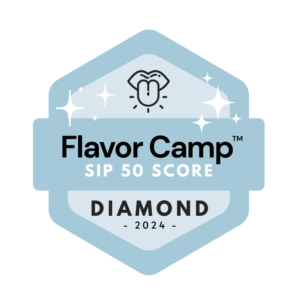For many, tasting spirits can be an intimidating experience. But for us, we like to think of it as a celebration – perhaps even a party, in your mouth.
Our mission is to teach people to drink better, together. And we do this by focusing on #flavorfirst.
Spirits tasting is a sensory examination and evaluation of what’s in the glass without other external factors influencing it.
On the other hand, drinking spirits is about creating an experience that can complement external factors (like a social setting, a conversation, a celebration, a mood etc.). Both have a time, place, and purpose.
Our intention is to teach you about both. We focus on the art of tasting, but also how beverages can be paired with other ingredients for a thoughtful and intentional experience. From crafting the perfect cocktail to pairing it with food to create an elevated culinary experience, we believe that by first understanding the unique aspects of the drink first, we can match it more thoughtfully and intentionally to make eating & drinking more adventurous.
We’re not just a library of resources, but rather we’re a community that educates, sparks discussion, runs monthly challenges, and highlights the discoveries and feedback of those involved.
Flavor Camp Tasting Systems
Our signature Flavor Camp Tasting Systems© uses multiple learning cues to help tasters retain & recall the full profiles of spirits. The combination of grouping information together in flavor camps, use of visual icons, color codes and taste association solidify the information in your brain more effectively.
How It Works

Step One: Determine the whisk(e)y’s tasting notes & organize by their corresponding flavor camps. If you’re new to tasting, review the brand’s recommended tasting notes & identify which flavor camps they fall into.
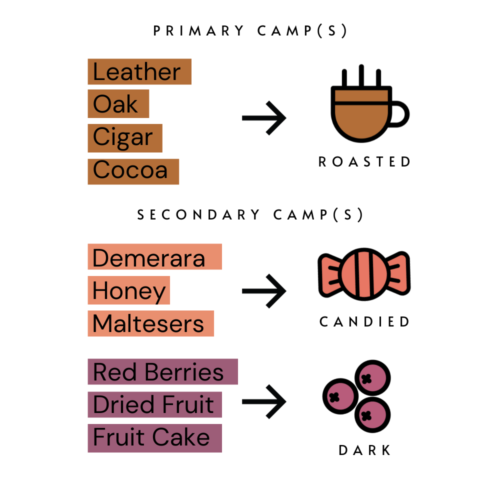
Step Two: Based on the overall frequency & intensity of flavors within each camp, assign one primary and one to three secondary flavor camps for the spirit. This is now their flavor camp profile.
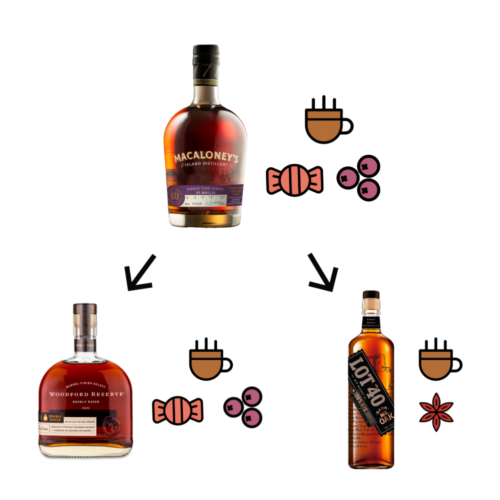
Step Three: Use this profile to discover & enjoy other whiskies with similar flavor camps as well as contrasting flavor camps.
The entire intention is to be able to taste and relate spirits that aren’t necessarily from the same country, same category or style. For example here, we have Macaloney Island Distillery St. Maille which is a single malt from BC, Canada. Based on its flavor camps, similar profiles include Woodford Reserve Double Oak (a bourbon from Kentucky, USA), and Lot No. 40 Dark Oak (a rye whisky from Ontario, Canada).
Benefits
Develop Your Taste Identification
For newer drinkers, this system simplifies complicated tasting notes so you can focus on the main flavors. Over time (and with more practice) they will become easier to recall and identify.
Grow Expertise in Buying Bottles & Making Recommendations
Understanding how each product relates to each other based on their flavor profile allows you to look for things within the same flavor camps & make thoughtful recommendations to others.
Master The Art of Blind Tasting
Once you understand what processes create each individual flavor & can identify the flavors blind, you can use these skills to anticipate what you’re tasting blind and/or assess the overall quality of the spirit with ease.
SIP Tasting & Scoring Methodology
The SIP Taste & Scoring System is a systematic approach used to evaluate and analyze spirits out of a total score of 50 points. Whether you choose to score or simply just commentate on each of the categories the combination of qualitative and quantitative evaluation helps us to remember what we liked, didn’t like and what we want to recommend to others.
-
Appearance (out of 5): Take a look at the color of the spirit, clarity (does it look clean and bright or dull and cloudy), and consistency (is it light in texture or thick and viscous). However, it’s important to remember that many spirit categories permit additives which will manipulate all of these aspects. Appearance is arguably the least important part of tasting.
Because the bottle design / branding matters to your purchasing perceptions, account for the 'appeal' of the bottle itself. - Aroma (out of 9): With the aroma, you are describing two main things: the intensity of the aroma and the flavors you detect on the nose. Are there countless notes you can detect or only a few? What are the notes? Are they agreeable to your nose or not? Is the ethanol prominent or integrated?
- Taste & Mouthfeel (out of 9): Similarly to aroma, the goal with tasting spirits is to determine the intensity of the flavor(s) and the actual flavors you detect. Is the palate similar to the aroma or does it taste completely different than your initial impressions? In terms of body/mouth feel, is it oily/creamy or light and tea-like? Is it mouth watering or mouth drying? Is the ethanol prominent or integrated?
- Finish (out of 5): Assess the duration, intensity, and complexity of the flavors and aromas that linger in the mouth. Is it long and pleasant, short and dissipating, or somewhere in between?
- Distinctiveness (out of 5): Is this something familiar to your palate or distinctive? Is there a particular tasting note/tasting profile that stands out to you?
- Overall Drinkability & Balance (out of 9): Is the spirit balanced? Is there a good integration between flavors, intensity, complexity & alcohol content? How’s the harmony between flavors? Anything overpower the other notes? Is the spirit superior in comparison to other you've tasted in this category? Would you want another sip?
- Value for Price (out of 8): Do you feel like the price point is good value for the overall quality of the spirit? Take into account any other special considerations (i.e. limited release, single barrel, age, ABV etc.).
SIP 50 Scoring
Not your average medals! For a spirit to receive a SIP 50 Score medal, at least 50 tasters must evaluate the spirit (in real life) out of 50 possible points based on 7 categories that include blind tasting, bottle design/appeal, overall value for price, distinctiveness and more. Watch for these medals in the spirits features on our website.
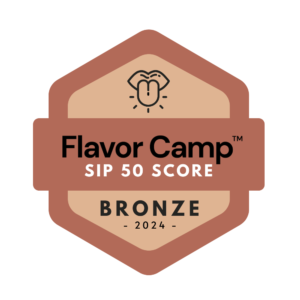
Score between 30.0 – 34.9
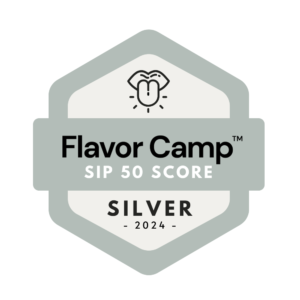
Score between 35.0 – 39.9

Score between 40.0 – 44.9
